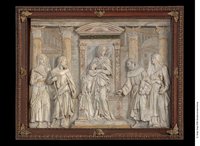After Donatello?
Virgin and Child with Seven Angels
Bronze
18 X 17.5 x 2 cm
The gilt wood frame that was around the relief until WWII is in the storage of the Bode-Museum. At the bottom of the bronze relief, coat of arms of the Pazzi family.
Berlin, Staatliche Museen, Skulpturensammlung, Inv. SKS 2847.
Bode-Museum, storage.
Provenance
Florence, Stefano Bardini (1904); Berlin, Skulpturensammlung/Kaiser-Friedrich-Museum (1904-1939); Berlin, storage (1939-1945); Merkers, storage (1945); Wiesbaden, Central Collecting Point (1945-1956); West Berlin, Skulpturensammlung/Museum Dahlem (1956-1990); Berlin, Skulpturensammlung/Museum Dahlem (1990-1997); Berlin, storage (1997-2006); Berlin, Skulpturensammlung/Bode-Museum (since 2006).
Acquisition
Gift of Mrs. Oskar Hainauer, 1904. Acquisition file: I. 3275 04 (now missing).
Other version
• Paris, Musée du Louvre, Inv. 9149. Bronze, diameter: 18 cm.
Comment
This work represents a seated Virgin and Child surrounded by a notable number of angels and cherubs: five angels play various instruments, two other are carrying a garland, while three cherubs are represented at the top of the composition. The work is closely related to a relief in the Musée du Louvre (Inv. 9149) which is similar except for the coat of arms of the Florentine family at the bottom (Pazzi in Berlin; Capponi in Paris). The Virgin’s pose and the garland are found in a relief by Donatello in the Kunsthistorisches Museum in Vienna (see a closer derivation in Berlin, Inv. SKS M 7). The crowd of angels calls to mind other inventions by Donatello (see for instance the sketch of the Virgin and Child with five Angels, also in Berlin Inv. SKS M 88). For all of these reasons, Wilhelm Bode attributed the relief to Donatello himself (Bode 1908, 1921, and 1925).
However, some weaknesses in the treatment of the anatomies – especially in comparison to the gilt bronze relief in Vienna – have hindered many art historians from accepting this attribution (even Bode and Tschudi 1888 were more cautious). The comparison with the Lombardi monument in the Sacristy of Santa Croce, Florence, has often been made, as the faces do look somewhat similar; however, the difference of technique and scale should refrain from a too close comparison. Radcliffe and Avery 1976, ed. 1988 have suggested the name of the sculptor Maso di Bartolomeo (see Mozzatti 2010, who is more cautious). The possibility remains that the relief (and the one in the Louvre) derives from a model in wax designed by Donatello, which was then cast and chiseled by another (less gifted) Florentine artist. According to Mike Riddick (written communication, January 2016) the Berlin version may be a severely debased aftercast, heavily reworked after the Louvre prototype.
Literature
Bode and Tschudi 1888
Wilhelm Bode and Hugo von Tschudi (eds.), Beschreibung der Bildwerke der christlichen Epoche, Berlin, W. Spemann, 1888, p. 17: the same sculptor created, among other works, a marble Virgin and Child in Berlin (Inv. SKS 57).
Bode 1902
Wilhelm Bode, Florentiner Bildhauer der Renaissance, Berlin, Bruno Cassirer, 1902, pp. 123, 124 fig. 55: after a wax model by Donatello.
Meyer 1903
Alfred Gotthold Meyer, Donatello, Bielefeld and Leipzig, Delhagen and Klafing, 1903, p. 118: school of Donatello the work was then in the collection of Mrs. Hainauer in Berlin.
Schubring 1907
Paul Schubring, Donatello. Des Meisters Werke in 277 Abbildungen, Stuttgart and Leipzig, Deutsche Verlags-Anstalt, 1907, p. 198: reproduces the Louvre version; close to the Lombardi monument in Santa Croce, Florence.
Bode 1908
Wilhelm Bode, “Ein Blick in Donatellos Werkstatt”, Monatshefte für Kunstwissenschaft, I, n°1-2, January-February 1908, pp. 8-9: Donatello.
Sirén 1909
Osvald Sirén, Florentinsk Renässansskultur och andra Konsthistoriska ämnen, Stockholm, Wahlström & Widstrand, 1909, p. 61: after Donatello.
Bode 1921
Wilhelm Bode, Florentiner Bildhauer
Entstehungsort stilistisch: Florenz
de

